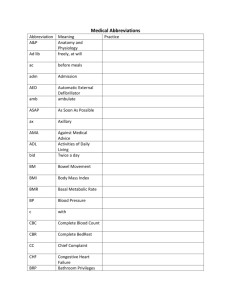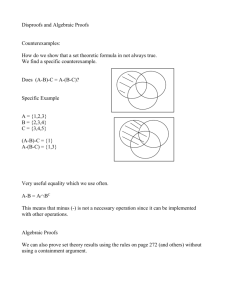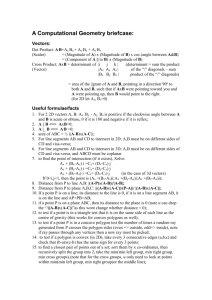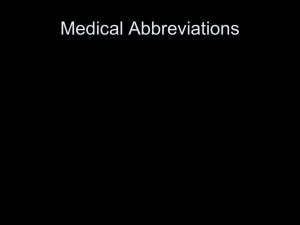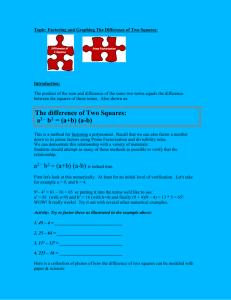ORDER/3
advertisement
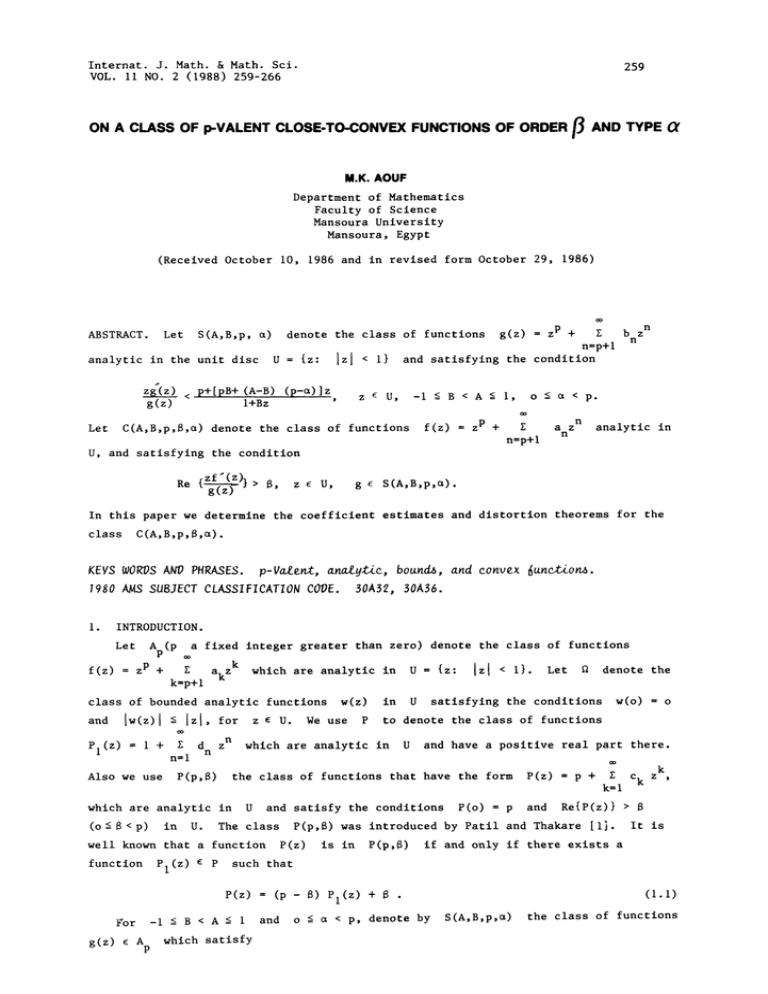
Internat. J. Math. & Math. Sci.
VOL. ii NO. 2 (1988) 259- 266
259
ON A CLASS OF p-VALENT CLOSE-TO-CONVEX FUNCTIONS OF
ORDER/3 AND TYPE
M.K. AOUF
Department of Mathematics
Faculty of Science
Mansoura University
Mansoura, Egypt
(Received October i0, 1986 and in revised form October 29, 1986)
S(A,B,p, =)
Let
ABSTRACT
<
g(z)
Izl
{z:
U
analytic in the unit disc
z(z)
denote the class of functions
p+[pB+ (A-B) (p-)]z
<
I}
-I
B < A
f(z)
C(A,B,p,8,) denote the class of functions
Let
z
p
n
b z
E
n
n--p+l
+
and satisfying the condition
z e U,
l+Bz
g(z)
z
p +
I,
< p.
o
E
n=p+l
a z
n
n
analytic in
U, and satisfying the condition
zf" (z)} > 8,
g(z[
Re
U,
z
S(A,B,p,=).
g
In this paper we determine the coefficient estimates and distortion theorems for the
C(A,B,p,8,).
class
KEYS WORDS AND PHRASES. p-Valent, analytic, bounds, and convex functions.
1980 AMS SUBJECT CLASSIFICATION CODE 30A32, 30A36.
I.
INTRODUCTION.
Let
f(z)
a fixed integer greater than zero) denote the class of functions
A (p
P
z
p
+
I
k=p+l
akzk
class of bounded analytic functions
lw(z) --< Izl,
and
+
P1 (z)
l
n--I
dn
for
zn
which are analytic in
(o-<-8 <p)
U.
in
Pl(Z)
U
-i
g(z)
A
P
<--
U
in
< I}.
e P
Let
denote the
w(o)
satisfying the conditions
o
to denote the class of functions
U
and have a positive real part there.
P(z)
p
+
l c z
k
k=l
Re{P(z)}
P(o)
p
and
k
>
8
P(p,8) was introduced by Patil and Thakare [i]. It
P(z) is in P(p,8) if and only if there exists a
and satisfy the conditions
The class
is
such that
P(z)
bor
e
which are analytic in
well known that a function
function
w(z)
We use
Izl
the class of functions that have the form
P(p,8)
Also we use
U.
z
{z:
U
which are analytic in
B < A-<-
which satisfy
(p
and
8)
o
P1(z)
+ 8
< p, denote
(i.I)
by
S(A,B,p,e)
the class of functions
260
M.K. AOUF
zf(z)
p+[pB+ (A-B) (p-a)]
+ Bz
<
g(z)
z
z
U.
S(A,B,p,a)
g(z)
By definition of subordination it follows that
tion of the form
zg’(z)
p+[pB + (A-B) (p-a) ]w(z)
1+Bw(z)
g(z)
S(A,B,p,a)
Obviously
w e
.
(1.2)
S (a), o
is a subclass of the class
P
a, investigated by Goluzina [2].
like functions of order
has a representa-
a< p,
of p-valent star-
S(A,B,p,a)
The class
introduced by the author [3].
Moreover, let
C(A,B,p,B,a)
denote the class of functions
f(z)
A
satisfy
{z_(z)}
g(z)
Re
which
g e S(A,B p a)
> 8
(1.3)
f(z) e C(A,B,p,8,a), then we may write
Thus if
zf’(z)
We note that
g(z) P(z),
(z)
Let
Z
n
n= o
,
(z)
z
8
n
P(p,fl).
P(z)
C(l,-l,l,fl,)
convex functions of order
(z)
P
C(8,),
and type
is a subclass of the class of close-to-
introduced by Libera [4].
c
(z)
and
(1.4)
n
B n z be any
Z
n= o
two functions
we shall mean the Hadamard product or convolution of
then by
(z)
and
(z),
that is
(z)
,
z
(z)
n
n=o
z
n
n
We state below some lemmas that are needed in our investigation.
LEMMA
[I].
P(z)
If
+ E
p
c
k=l
c
The function
-< 2(p
n
P (z)
o
8) for all
p+(p-28)
I-
o
81z
If
P(z)
p-lp-213.l.r
l+r
Equality occurs for
LEMMA 3 [5].
in
U
such that
LEMMA 4 [3].
(1.5)
n.
(1.6)
n >
I.
Izl
P(p,8), then for
_<
P (z)
o
ip(z)
<
g(z)
r <
p+lp-2131,r
(1.7)
l-r-
defined by (1.6)
If (z) is regular in
(z) < (z), then (z)
If
P(p,B), then
18
61z
shows that the result is sharp for each
I].
k
defined by
P (z)=
LEMMA 2
z
k
z
p
+
Z
n=p+l
U, (z)
,
b
n
and
h(z)
h(z) < (z)
z
n
S(A,B,p )
,
are convex univalent
h(z), z
then for
U.
n
p+l
CLASS OF P-VALENT CLOSE-TO-CONVEX FUNCTIONS
n-(p+l)
261
(B-A) (p-a)+Bj
(1.8)
j=o
go(Z)
The function
defined by
zP(I+B 62z)
go(Z)
(A-B)
B
shows that the result is sharp for each
2.
f(z)
If
n-(p+l)
,,lanl _-<
n
z
p
+
E
n=p+l
l(m_A)(p_a)+Bj[ +
(j+l)
=o
p+l.
n
C(A,B,p,B,a).
COEFFICIENT ESTIMATES FOR THE CLASS
THEOREM I.
1621
B # o,
a
z
n
n
C(A,B,p,B,), then for
2(p-B)[I+
n
n-(p+2)
Z
k
k--o
j =o
p+l
n
(B-A) (p-a)+Bj
(j+l)
].
(2.1)
The result is sharp.
PROOF.
f
Since
C(A,B,p,B,a), it follows that
zi(z)
g(z)
here
z
p
+ r.
k=l
(2.2)
g(z) P(z),
bp+k zp+k
S(A,B,p,)
and
r.
p +
P(z)
c
k=l
z
k
k
P(A,B,p,8).
Hence
[pz p +
E
k=l
Equating coefficients of
na
Pbn
n
[z p +
(p+k)ap+k z p+k]
+
c
z
+
Ibn-I
n
Z
b
k=
p+k
p+k
z
x [p
+
l
k=
c
k
z
k]
(2.3)
on both sides of (2.3), we obtain
C2bn_ 2
+
+ c n-p-I
b
p+1
+ c n-p
This gives
nlanl--< Plbnl + IClllbn_ll + Ic211bn_21
+
+
ICn_p_lllbp+ll
+
(2.4)
Substituting the value from (1.5) and (1.8) in (2.4), we obtain
takes the form of (2 I)
which, on simplification
f’(z)
O
z
p-I
P+(P-2B)IZ
iz
II I21
(I+B
2 z)
(I)
Choosing
Mehrok [6].
p=l
f (z)
O
defined by
B # o,
(2.5)
I,
shows that the bound (2.1) is sharp for each
Remarks on Theorem
The function
(A-B)
B
n >
p+l.
I.
and
=B=o
in Theorem
I,
we get the result due to Goel and
M.K. AOUF
262
(2)
p=l, A=I, B=-I
Choosing
e==o
and
in Theorem
I, we get the result due
to
Reade [7].
3.
DISTORTION THEOREMS.
LEM 5.
If
Isl
S(A,B,p,), then for all
g
tP_!z__ztPg(sz--)
B
B#o"
exp [A(p-) (s-t)z],
sPg(tz)
I, (s#t)
A-B)(p-a)
(I+Bsz)
(I+Btz)
sPg(tz)
Itl
I,
(3.1)
(3.2)
B=o.
The proof is similar to the one given by Ruscheweyh [8] and Goel and
PROOF.
Mehrak [6].
B#o.
We first consider the case when
We have
p+[pB+(A-B) (p-e) ]z
I+Bz
zg(z)
g(z)
z
U.
6
This implies that
zg(z)
where
p+[ pB+ (A_-
-P
g z
1---+z
_(A-B)(p-e)z.
(A-B) (_p-) z
-P
U.
is convex, univalent in
I+Bz
7
h(z)
s
l-su
o
Isl
For
-<
Itl
-<
(s#t)
(3.4)
)du
(3.3) and (3.4) satisfy the conditions of lemma 3, and
U.
is convex, univalent n
t
1-tu
(3.3)
l+-------Bz
therefore
z(z)
[-5-
(A-B) (p-)
h(z) <
-P]*
(l+Bz)
q(z)
Now for every analytic function
q(z)
,
sz
h(z)
q(u)
f
.
h(z).
with
(3.5)
q(o)
o, we have
du
tz
(3.6)
u
By the application of (3.6), (3.5) can be written as
SZ
[ug(u)
g(u)
I
tz
du
< (A-B) (p-a)
u
-p
SZ
I
du
I+Bu
tz
from which (3.1) follows.
B=o, we obtain (3.2).
Similarly for
LEMMA 6.
rP(l_Br)
r
p
zl
S(A,B,p,e), then for
If g
(A-B) (p-a)
B
exp(-A(p-e)r) <
larg
z
arg
p
-I
z
p
<
Ig(z)I
<
Ig(z)]
< rp
(A-B)(p-e)
B
-< A(p-e)r
<_
rP(l+Br)
exp(A(p-x)r), B
sin
-1
r <
(A-B) (p-e)
B
(Br),
o.
B # o,
B#o,
(3.7)
(3.8)
(3.9)
,3.
lo)
CLASS OF p-VALENT CLOSE-TO-CONVEX FUNCTIONS
go(Z)
These bounds are sharp, being attained by the function
zP(I+B z)
go(Z)
z P exp
(A-B) (p-)
B
(A(p-a)2z)
B
o,
B
o,
..1821
263
defined by
I.
The author [3] proved the results in lemma 6 using a different method.
PROOF.
However, we deduce them from lemma 5.
Taking s=l, t=o in (3.1) and (3.2), we get
(A-B) (p-a)
g(z)
z
p
L(Z)
z
(I+Bz)"’
p
<
B
B # o,
(3.11)
exp(A(p-a)z)
B=o.
(3.12)
g(z___)
(3.11) implies that
z
(i)
When
B
](I+Bw(z))
(A-B) (p-a)
B
[exp[ (AT.B,)(p-a)
B
exp
log (l+Bw(z))]
Re[A_,,p_e,[n
B
exp((A-B_)(P-)
B
<
B< o, put
log
l+Bw(z)
(A-B) (p-a)
B
B =-C, C >o.
(A-B) (p-.),
[(l+Bw(z))
log(1+Bw(z))]
(A-B)
B
I+Bw(z)
< (l+Br)
When
B#o.
o
[.z)[
(ii)
(A-B)
B
(1+Bw(z))
p
B
(A-B) (p-)
[((l-Cw(z)) -I)
(1-Cw(z))-l]
-<
--cr
C
(A-B) (p-a)
C
(A-B) (p-a)
c
(A-B) (p-a)
B
(l+Br)
Similarly (3.8) is a direct consequence of (3.12).
For Izl
r, from (3.11), we get
[arg (z)
p
z
(A-B)(p-d)
B
[arg
(l+Bw(z))
<
(A-B)(p-a)
Similarly (3.10) is a direct consequence of (3.12).
B
sin
-I
(Br).
264
M.K. AOUF
THEOREM 2.
If
C(A,B,p,,a), then for
f
(X-B)
rP-1
P.,.- Ip-2fl r
l+r
rP-1
p+lp.2S[r
rp-
r_
rP-1
+_-2Blr1_r
l-r
r
r
r
r
f
r
B
B
f(z)[
dr
B
p-I
p+lp-21[r
1-r
(3.14)
o;
(A-B) (p-a)
P-IP-l+r2B exp(-A(p-a)r)dr
o
(3.13)
(A-B) (p-a)
(1-Br)
p-I
o
<
B # o
exp (A(p-a)r)
p!Ip-2Slrl_r (l+Br)
o
f
(a-) (p-a;
B
r<
l(z)]
[f’(z)[
l+r
rP_l
-<
B
exp(-A(p-a)r)
P--]P- 2
p-1
o
dr
(l+Br)
l+r
r
f
(1-Br)
[z[
dr
<
If(z)]
B # o’,
(3.15)
B
(3.16)
<
exp (A(p-a) r)dr
o
All those inequalities are sharp.
PROOF.
From (2.2), we have
Ig()ll
z
f’(-)i
(3.17)
p(z)
Using (1.7), (3.7) and (3.8) in (3.17), we obtain (3.13) and (3.14).
Now
r
Iso (-)
If(z)l
dz
r
-< f I(z)l
dr
o
r
r
Let
r.
z
p-1
l-r
p-I
ol
L(z
If
p+lp-2Bl r
l-r
z
O
P*lP-Z.lr-’"^’
O
r
(l+Br)
(A-B) (p-)
B
exp (A (p-)r) dr,
B #
dr
B
o.
be chosen in such a way that
f(z
is the pre-image of the segment [o
Cr p-I
f r
o"
P-lP’2BIr
l+r
o)1
f(Zo)]
<
If(z)
for all
U, then
(A-B) (p)
--dr
B
(l-Br)
z
in
B # o;
,O
If(= o )I
l(z) Idr-->
17<z)lld-I
f
L(z o
L(z
o
; rP-1 p_-lp-2Blr
o
l+r
exp(-A(p-e)r)dr,
B
o.
CLASS OF P-VALENT CLOSE-TO-CONVEX FUNCTIONS
(3.14), (3.15) and (3.16)
defined by (2.5) with B # o and
Equality signs in (3.13),
f (z)
o
f:(z)
z
p-I P+(P-2-)iz
I-
are attained by the function
exp(A(p-a) 2 z)
1z
265
B
o
lII I21
Remarks on Theorem 2.
p=l
Choosing
and
a=6=o
in Theorem 2, we get the result due to Goel and
Mehrok [6].
4.
fz).
ARGUMENT OF
LEflA 7.
Let
p+(p-213)r
[P(z)
PROOF.
p(z) e P(p,8).
2
<
r,
<- 2(p-13)r
2
2
l_r
(4.1)
l_r
It is well known [9] that for
l+r21
IP l(z) l-r2,
Izl
Then for
<
Pl(Z)
e P
2r
(4.2)
i_r2
Thus the result follows from (I.I) and (4.2).
LEMMA 8.
P(z) e P(P,8), then
If
[arg P(z)]
2(p-B)r
sin"
<
p+(p-28)r
Izl
2,
The bound is sharp.
PROOF. The proof follows from Lemma 7.
1+(1-
P(z)
p
-) 1
(4.3)
-o
To see that the result is sharp, let
z
iz
2B
1 =rz
THEOREM 3.
[arg
i/I-(l- 21B)2
P
i-( I-
f’(z)
(A-B) (p-a)
sin-I (Br)
B
[arg
--f’(z)
z
I-(I- :P
2
/l_r 2
(4.4)
r
C(A,B,p,B,a), then
f
If
2--8)r2
P
r
p-1
_<
+
sin
-I
2(p-8)r
p+(p-28)r
A(p-a)r + sin
-1
2(p-B)r..
2
p+(p_2B)r
B # o
2
B
(4.5)
(4.6)
o.
These inequalities are sharp.
PROOF.
From (2.2), we have
f
(g___z_)_ P(z).
z__)=
p-1
zP
z
arg
f’(z)
z
p-I
arg
g(z)
z
p
Thus
(4.7)
+ arg P(z)
Using (3.9), (3.10) and (4.3) in (4.7), we obtain (4.5) and (4.6).
(4.5) and (4.6) hold for the function
fl(z)
and
f2(z)
Equality signs
respectively, where
in
266
M.K. AOUF
p z
’1(z)
+
p-I
28) z
(I-____1__
(I+B
2
gl z
2(z)
pz
+ (I-
p-1
2--B)6
p
z)
z
exp(A(p-a)
61z
yz)
where
2_B)2r2 /1-r 2
P
2
1-(1- 2g)r
i/l-(1-
P
r
z
2
[-Br +
2i61-B2r
].
Remarks on Theorem 3.
(])
Choosing
p=1
and
a=8=o
in Theorem 3, we get the result due to Goel and
Mehrok [6].
(2)
Si]verman
(3)
Choosing
p=l, A=I
B= -I
and
in Theorem 3, we get the result due to
[10].
Choosing
p=1, A=I, B= -I
and
a=B=o
in Theorem 3, we get the result due
to Ogawa [II] and Krzyz [12].
REFERENCES
I.
PATIL, D.A. and THAKARE, N.K. "On Extreme Points of Functions of Order a With
Positive Real Part and Related Results", Indian J. Pure Appl. Math. 9(1978),
1353-1358.
2.
GOLUZINA, E.G.
3.
AOUF, M.K.
"On the Coefficients of a Class of Functions, Regular in a Disk
and Having an Integral Representation in It", J. of Soviet Math. 6(1974),
606-617.
4.
"On a Class of p-Valent Starlike Functions of Order a", Submitted.
LIBERA, R.J. "Some Radius of Convexity Problems", Duke Math. J. 31(1964),
143-158
5.
6.
7.
RUSCHEWEYH, St. and SHEIL-SMALL, T. "Hadamard Product of Schlicht Functions and
the Poya-Schoenberg Conjecture", Comment. Math. Helv. 4__8(1973), 119-135.
GOEL, R.M. and MEHROK, B.S. "On A Class of Close-To-Convex Functions", Indian
J. Pure Appl. Math. 12(1981), 648-658.
READE, M.O. "On Close-To-Convex Univalent Functions", Mich. Math. J. (1955),
8.
59-62.
RUSCHEWEYH, St. A Subordination Theorem for -Like Functions", J. London Math.
Soc. 13(1976), 275-280.
9.
NEHARI, Z.
i0.
Conformal Mapping, New York, 1952.
SILVERMAN, H.
"Convexity Theorems for Subclasses of Univalent Functions",
64(1976), 253-263.
Pacific J. of Maths.
11.
OGAWA, S. "A Note on Close-To-Convex Functions", J. Nara Gakugei Univ. 8(1959),
9-10.
12.
KRZYZ, J. "On the Derivative of Close-To-Convex Functions", Coll. Math. 10(1963),
139-142
Present Address- Department of Mathematics, Faculty of
Science, University of Qatar,
P.O. Box: 2713, Doha
Qatar

